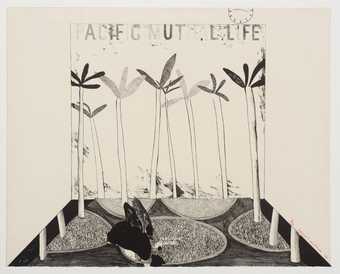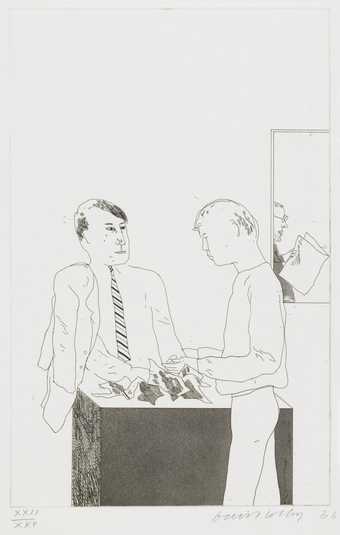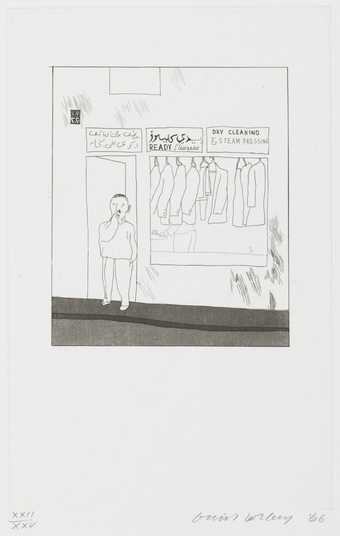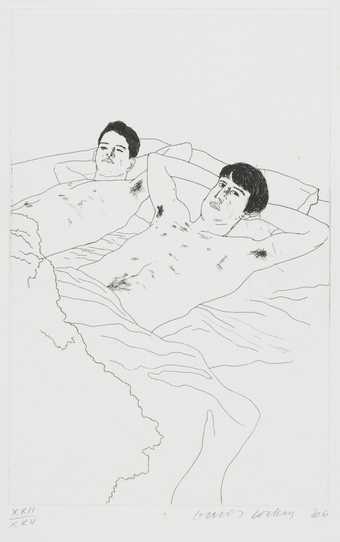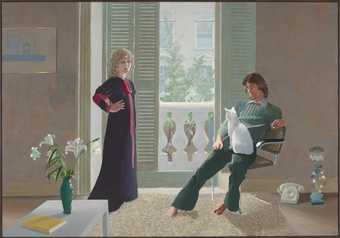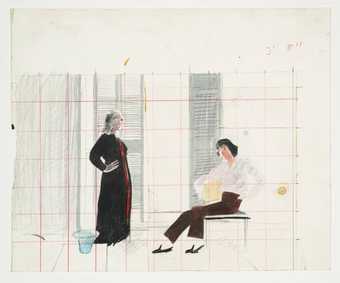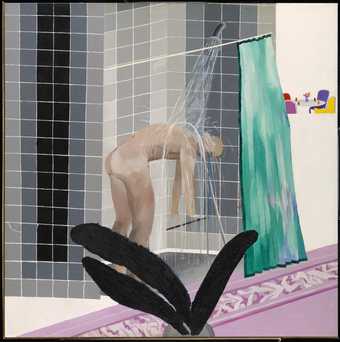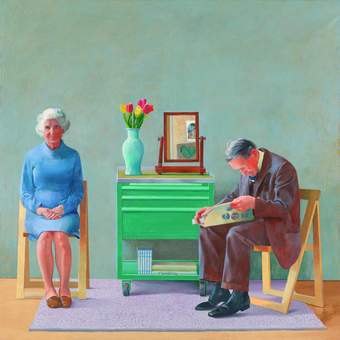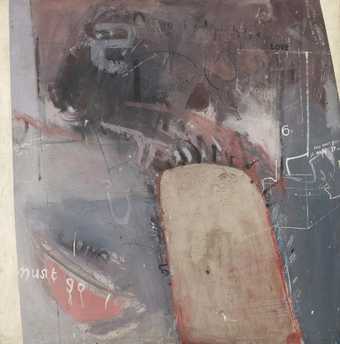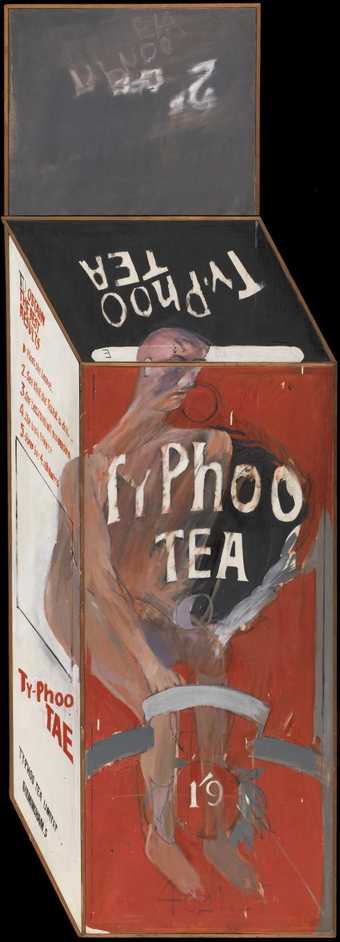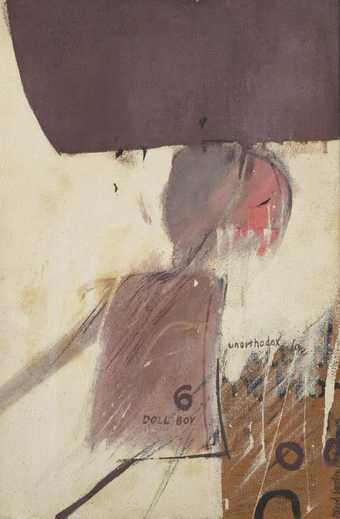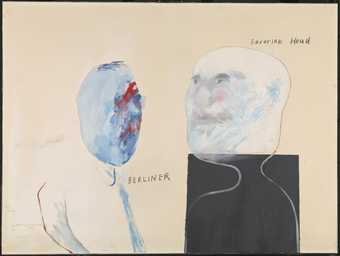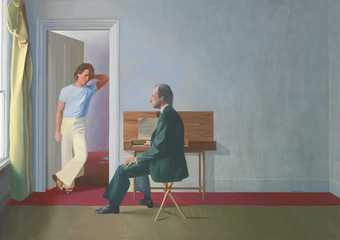
In Tate Britain
- Artist
- David Hockney born 1937
- Medium
- Acrylic paint on canvas
- Dimensions
- Support: 2425 × 2439 × 30 mm
- Collection
- Tate
- Acquisition
- Purchased 1981
- Reference
- T03254
Summary
This painting depicts a splash in a Californian swimming pool. Hockney first visited Los Angeles in 1963, a year after graduating from the Royal College of Art, London. He returned there in 1964 and remained, with only intermittent trips to Europe, until 1968 when he came back to London. In 1976 he made a final trip back to Los Angeles and set up permanent home there. He was drawn to California by the relaxed and sensual way of life. He commented: ‘the climate is sunny, the people are less tense than in New York ... When I arrived I had no idea if there was any kind of artistic life there and that was the least of my worries.’ (Quoted in Kinley, [p.4].) In California, Hockney discovered, everybody had a swimming pool. Because of the climate, they could be used all year round and were not considered a luxury, unlike in Britain where it is too cold for most of the year. Between 1964 and 1971 he made numerous paintings of swimming pools. In each of the paintings he attempted a different solution to the representation of the constantly changing surface of water. His first painted reference to a swimming pool is in the painting California Art Collector 1964 (private collection). Picture of a Hollywood Swimming Pool 1964 (private collection) was completed in England from a drawing. While his later swimming pools were based on photographs, in the mid 1960s Hockney’s depiction of water in swimming pools was consciously derived from the influences of his contemporary, the British painter Bernard Cohen (born 1933), and the later abstract paintings by French artist Jean Dubuffet (1901-85). At this time he also began to leave wide borders around the paintings unpainted, a practice developed from his earlier style of keeping large areas of the canvas raw. At the same time, he discovered fast-drying acrylic paint to be more suited to portraying the sun-lit, clean-contoured suburban landscapes of California than slow drying oil paint.
A Bigger Splash was painted between April and June 1967 when Hockney was teaching at the University of California at Berkeley. The image is derived in part from a photograph Hockney discovered in a book on the subject of building swimming pools. The background is taken from a drawing he had made of Californian buildings. A Bigger Splash is the largest and most striking of three ‘splash’ paintings. The Splash (private collection) and A Little Splash (private collection) were both completed in 1966. They share compositional characteristics with the later version. All represent a view over a swimming pool towards a section of low-slung, 1960s modernist architecture in the background. A diving board juts out of the margin into the paintings’ foreground, beneath which the splash is represented by areas of lighter blue combined with fine white lines on the monotone turquoise water. The positioning of the diving board – coming at a diagonal out of the corner – gives perspective as well as cutting across the predominant horizontals. The colours used in A Larger Splash are deliberately brighter and bolder than in the two smaller paintings in order to emphasise the strong Californian light. The yellow diving board stands out dramatically against the turquoise water of the pool, which is echoed in the intense turquoise of the sky. Between sky and water, a strip of flesh-coloured land denotes the horizon and the space between the pool and the building. This is a rectangular block with two plate glass windows, in front of which a folding chair is sharply delineated. Two palms on long, spindly trunks ornament the painting’s background while others are reflected in the building’s windows. A frond-like row of greenery decorates its front. The blocks of colour were rollered onto the canvas and the detail, such as the splash, the chair and the vegetation, painted on later using small brushes. The painting took about two weeks to complete, providing an interesting contrast with his subject matter for the artist. Hockney has explained: ‘When you photograph a splash, you’re freezing a moment and it becomes something else. I realise that a splash could never be seen this way in real life, it happens too quickly. And I was amused by this, so I painted it in a very, very slow way.’ (Quoted in Kinley, [p.5].) He had rejected the possibility of recreating the splash with an instantaneous gesture in liquid on the canvas. In contrast with several of his earlier swimming pool paintings, which contain a male subject, often naked and viewed from behind, the ‘splash’ paintings are empty of human presence. However, the splash beneath the diving board implies the presence of a diver.
Further reading:
David Hockney: Paintings, Prints and Drawings 1960-1970, exhibition catalogue, Whitechapel Gallery, London 1970
Stephanie Barron, Maurice Tuchman, David Hockney: A Retrospective, exhibition catalogue, Los Angeles County Museum of Art, Metropolitan Museum of Art, New York and Tate Gallery, London 1988, p.38, reproduced p.158, pl.37 in colour and p.39, fig.24 (detail)
Catherine Kinley, David Hockney: Seven Paintings, exhibition brochure, Tate Gallery, London 1992, [p.5], reproduced [p.5] in colour
Catherine Kinley/Elizabeth Manchester
February 1992/March 2003
Does this text contain inaccurate information or language that you feel we should improve or change? We would like to hear from you.
Display caption
A Bigger Splash is one of a number of paintings Hockney made of Californian swimming pools. He has captured the moment just after someone has dived in. The splash is the only clue to their presence in the scene. Hockney was interested in using paint to capture transparent materials such as water, and fleeting moments, like the splash. The 1960s are often seen as the time that Britain emerged from the difficulties of the post-war years into a period of optimism. This colourful work seems to reflect this feeling.
Gallery label, July 2020
Does this text contain inaccurate information or language that you feel we should improve or change? We would like to hear from you.
Catalogue entry
T03254 A BIGGER SPLASH 1967
Inscribed ‘DAVID HOCKNEY’ on stretcher
Acrylic on cotton duck, 95 1/4×96 (242.5×243.9)
Purchased from the Marquis of Dufferin and Ava through the Knoedler Gallery (Grant-in-Aid) 1981
Prov: the Marquis of Dufferin and Ava (purchased from Kasmin Ltd, 1968)
Exh: David Hockney: a splash, a lawn, two rooms, two stains, some neat cushions and a table... painted, Kasmin Ltd, January–February 1968 (works not numbered, repr.); David Hockney: Paintings, Prints and Drawings 1960–1970, Whitechapel Art Gallery, April–May 1970 (67.5, repr.); David Hockney, Kestner-Gesellschaft, Hanover, May–June 1970 (41, repr.); David Hockney: Slike, Crtezi, Grafike 1960–1970, Muzej Savremene Umetnosti, Belgrade, September–October 1970 (30, repr.); David Hockney: Tableaux et Dessins, Musée des Arts Décoratifs, Paris, October–December 1974 (13, repr.in colour)
Lit: Nikos Stangos (ed.), David Hockney by David Hockney, 1976, pp.124–6, repr.in colour pl.190; Henry Geldzahler, ‘Hockney Abroad: A Slide Show’, Art in America, LXIX, February 1981, pp.136–7, repr.; Marco Livingstone, David Hockney, 1981, pp.108–11, repr.pl.59; Carolyn Lamb, ‘David Hockney “A Bigger Splash”’, Completing the Picture: Materials and Techniques of Twenty-six Paintings in the Tate Gallery, 1982, pp.108–13, repr.in colour p.109
Repr: The Tate Gallery: Illustrated Biennial Report 1980–82, 1983, p.51 in colour
A detailed discussion of this picture, by a member of the Tate Gallery's Conservation Department, is to be found in Completing the Picture (op.cit.). Part of it was based on written replies by the artist to a questionnaire. Extracts from this essay concerning the painting's style and subject matter, but also to a certain extent the techniques employed, are reprinted below.
'“A Bigger Splash” was painted sometime between April and June 1967 while Hockney was teaching at the University of California, Berkeley, USA. The Splash is based on a photograph he found in a book on the subject of building a swimming pool, and the background is taken from one of his drawings of Californian buildings. In many of his paintings the subject matter is a composite of personally observed details and photographic images. He feels photographs do not in themselves contain enough information to draw from but they can be developed imaginatively or used as mnemonic devices. He does not aim to produce an exact replica of the photograph.
'Discussing “A Bigger Splash” in his autobiography Hockney describes his fascination with the depiction of such an ephemeral thing as a water splash. “I love the idea first of all of painting like Leonardo, all his studies of water, swirling things. And I loved the idea of painting this thing that lasts for two seconds: it takes me two weeks to paint this event that last for two seconds” (David Hockney by David Hockney, p.124).
'The Splash was developed in three paintings. “A Little Splash” (1966) was the first version, only 16 × 20in. in size. This idea was enlarged and modified into “The Splash” (1966). Unsatisfied with the background, which he felt was too complicated, he simplified the building and landscape in the final version “A Bigger Splash” (1967). It is the largest of the three, 95 1/2 × 96in. in dimension, painted in Liquitex artists’ acrylic emulsion paint on cotton duck canvas.’
'...Hockney was greatly impressed by the acrylic paint he found in a Los Angeles art store when he moved there in 1963, and in fact gave up oils, using acrylic almost exclusively from this date until 1972. “The clear light of California suggested simple techniques as the light in a London room suggested an older ‘chiaroscuro’ technique.”
'Two painting techniques have been used in “A Bigger Splash”. Firstly a masking technique and secondly the more traditional application of paint by brush. Describing the picture, Hockney says “It's very strong Californian light, bold colour, blue skies. I rolled it on with rollers and the splash itself is painted with small brushes and little lines, it took me about two weeks to paint the splash” (David Hockney by David Hockney, p.124). The colours used were cobalt blue, ultramarine blue, raw sienna, burnt sienna, raw umber, Hookers green, Naples yellow and titanium white. These were applied mixed together or as tints (i.e. colour plus white for the sky and pool blue). Hockney stapled the canvas to his studio wall while he painted it. Not all of the canvas was covered by paint, the thin strip running horizontally across the centre of the painting (acting as the pool edge), and the wide canvas border were left unpainted. A canvas border was a frequently used pictorial device in his work between 1964 and 1967 - “It was a kind of concession to current art. It seemed to me that if I cut the picture off there, it became more conventional, and I was still a little frightened of that then” (ibid., p.125). No preliminary drawing was done on the canvas.’
Published in:
The Tate Gallery 1980-82: Illustrated Catalogue of Acquisitions, London 1984
Film and audio
Features
Explore
- architecture(30,960)
-
- garden structures(1,939)
-
- swimming pool(24)
- residential(5,553)
-
- house(2,675)
- formal qualities(12,454)
-
- space(177)
- time(679)
- recreational activities(2,836)
-
- bathing / swimming(220)
- USA(622)
You might like
-
David Hockney Pacific Mutual Life
1964 -
David Hockney Hotel Acatlan: Second Day
1984–5 -
David Hockney He Enquired After the Quality
1966 -
David Hockney To Remain
1966 -
David Hockney One Night
1966 -
David Hockney In Despair
1966 -
David Hockney Mr and Mrs Clark and Percy
1970–1 -
David Hockney Study for ‘Mr and Mrs Clark and Percy’
1970 -
David Hockney Man in Shower in Beverly Hills
1964 -
David Hockney My Parents
1977 -
David Hockney The Third Love Painting
1960 -
David Hockney Tea Painting in an Illusionistic Style
1961 -
David Hockney Study for Doll Boy
1960 -
David Hockney The Berliner and the Bavarian
1962 -
David Hockney George Lawson and Wayne Sleep
1972–5

